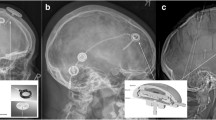Abstract
Object
The advances in shunt valve technology towards modern adjustable differential pressure (DP) valves and adjustable gravitational assisted valves result in an increasing complexity of therapeutical options. Modern telemetric intracranial pressure (ICP) sensors may be helpful in their application for diagnostic purposes in shunt therapy. We present our first experiences on telemetric ICP-guided valve adjustments in cases with the combination of an adjustable DP valve and adjustable gravitational unit.
Methods
Four consecutive cases were evaluated in a retrospective review who had received a proGAV adjustable, gravitational assisted DP valve with secondary in-line implantation of an adjustable shunt assistant (proSA), together with a telemetric ICP sensor (Neurovent-P-tel) between December 2010 and June 2012 in our institution. The measured ICP values and the corresponding valve adjustments were analyzed in correlation with the clinical course and the cranial imaging of the patients.
Results
No surgery-related complications were observed after implantation of the proSA and the telemetric ICP sensor additional to the proGAV. ICP values could actively be influenced by adjustments of the respective valve units. An increase of the position depending resistance of the proSA resulted in significant attenuated negative ICP values for the standing position, while adjustments of the proGAV could be detected not only in a supine position but also in a standing position. A clinical improvement could be achieved in all cases.
Conclusion
The combination of adjustability in the differential pressure valve and the gravitational unit reveals a complex combination which may be difficult to adapt only according to clinical information. Telemetric ICP-guided valve adjustments seem to be a promising tool as an objective measure according to different body positions. Further investigations are needed to select the patients for these costly implants.


Similar content being viewed by others
References
Allin DM, Czosnyka ZH, Czosnyka M et al (2006) In vitro hydrodynamic properties of the Miethke proGAV hydrocephalus shunt. Cerebrospinal Fluid Res 3:9. doi:10.1186/1743-8454-3-9
Bergsneider M, Miller C, Vespa PM, Hu X (2008) Surgical management of adult hydrocephalus. Neurosurgery 62(Suppl 2):643–659. doi:10.1227/01.neu.0000316269.82467.f7, discussion 659–660
Bergsneider M, Yang I, Hu X et al (2004) Relationship between valve opening pressure, body position, and intracranial pressure in normal pressure hydrocephalus: paradigm for selection of programmable valve pressure setting. Neurosurgery 55:851–858, discussion 858–859
Czosnyka M, Czosnyka Z, Pickard JD (2012) Programmable shunt assistant tested in Cambridge shunt evaluation laboratory. Acta Neurochir Suppl 113:71–76. doi:10.1007/978-3-7091-0923-6_15
Eide PK, Sorteberg W (2008) Changes in intracranial pulse pressure amplitudes after shunt implantation and adjustment of shunt valve opening pressure in normal pressure hydrocephalus. Acta Neurochir (Wien) 150:1141–1147. doi:10.1007/s00701-008-0138-8, discussion 1147
Freimann FB, Sprung C (2012) Shunting with gravitational valves—can adjustments end the era of revisions for overdrainage-related events? J Neurosurg 117(6):1197–1204. doi:10.3171/2012.8.JNS1233
Freimann FB, Vajkoczy P, Sprung C (2013) Patients benefit from low-pressure settings enabled by gravitational valves in normal pressure hydrocephalus. Clin Neurol Neurosurg 115(10):1982–1986. doi:10.1016/j.clineuro.2013.06.010
Gebert AF, Schulz M, Haberl H, Thomale U-W (2013) Adjustments in gravitational valves for the treatment of childhood hydrocephalus-a retrospective survey. Childs Nerv Syst 29(11):2019–2025. doi:10.1007/s00381-013-2160-2
Kajimoto Y, Ohta T, Miyake H et al (2000) Posture-related changes in the pressure environment of the ventriculoperitoneal shunt system. J Neurosurg 93:614–617. doi:10.3171/jns.2000.93.4.0614
Kiefer M, Antes S, Leonhardt S et al (2012) Telemetric ICP measurement with the first CE-approved device: data from animal experiments and initial clinical experiences. Acta Neurochir Suppl 114:111–116. doi:10.1007/978-3-7091-0956-4_20
Kiefer M, Antes S, Schmitt M et al (2011) Long-term performance of a CE-approved telemetric intracranial pressure monitoring. Conf Proc IEEE Eng Med Biol Soc 2011:2246–2249. doi:10.1109/IEMBS.2011.6090426
Kulkarni AV, Riva-Cambrin J, Butler J et al (2013) Outcomes of CSF shunting in children: comparison of Hydrocephalus Clinical Research Network cohort with historical controls. J Neurosurg Pediatr 12(4):334–338. doi:10.3171/2013.7.PEDS12637
Lemcke J, Meier U (2010) Improved outcome in shunted iNPH with a combination of a Codman Hakim programmable valve and an Aesculap-Miethke ShuntAssistant. Cen Eur Neurosurg 71:113–116. doi:10.1055/s-0029-1241179
Lemcke J, Meier U, Müller C et al (2013) Safety and efficacy of gravitational shunt valves in patients with idiopathic normal pressure hydrocephalus: a pragmatic, randomised, open label, multicentre trial (SVASONA). J Neurol Neurosurg Psychiatr 84:850–857. doi:10.1136/jnnp-2012-303936
O’Hayon BB, Drake JM, Ossip MG et al (1998) Frontal and occipital horn ratio: a linear estimate of ventricular size for multiple imaging modalities in pediatric hydrocephalus. Pediatr Neurosurg 29:245–249
Orakcioglu B, Beynon C, Kentar MM et al (2012) Intracranial pressure telemetry: first experience of an experimental in vivo study using a new device. Acta Neurochir Suppl 114:105–110. doi:10.1007/978-3-7091-0956-4_19
Rohde V, Haberl E-J, Ludwig H, Thomale U-W (2009) First experiences with an adjustable gravitational valve in childhood hydrocephalus. J Neurosurg Pediatr 3:90–93. doi:10.3171/2008.11.PEDS08154
Sprung C, Schlosser H-G, Lemcke J et al (2010) The adjustable proGAV shunt: a prospective safety and reliability multicenter study. Neurosurgery 66:465–474. doi:10.1227/01.NEU.0000365272.77634.6B
Toma AK, Tarnaris A, Kitchen ND, Watkins LD (2011) Use of proGAV® shunt valve in normal-pressure hydrocephalus. Neurosurgery 68:245–249. doi:10.1227/NEU.0b013e318214a809
Thomale U-W, Gebert AF, Haberl H, Schulz M (2013) Shunt survival rates by using the adjustable differential pressure valve combined with a gravitational unit (proGAV) in pediatric neurosurgery. Childs Nerv Syst 29:425–431. doi:10.1007/s00381-012-1956-9
Weinzierl MR, Rohde V, Gilsbach JM, Korinth M (2008) Management of hydrocephalus in infants by using shunts with adjustable valves. J Neurosurg Pediatr 2:14–18. doi:10.3171/PED/2008/2/7/014
Welschehold S, Schmalhausen E, Dodier P et al (2012) First clinical results with a new telemetric intracranial pressure-monitoring system. Neurosurgery 70:44–49. doi:10.1227/NEU.0b013e31822dda12, discussion 49
Zemack G, Romner B (2008) Adjustable valves in normal-pressure hydrocephalus: a retrospective study of 218 patients. Neurosurgery 62(Suppl 2):677–687. doi:10.1227/01.neu.0000316272.28209.af
Author information
Authors and Affiliations
Corresponding author
Rights and permissions
About this article
Cite this article
Freimann, F.B., Schulz, M., Haberl, H. et al. Feasibility of telemetric ICP-guided valve adjustments for complex shunt therapy. Childs Nerv Syst 30, 689–697 (2014). https://doi.org/10.1007/s00381-013-2324-0
Received:
Accepted:
Published:
Issue Date:
DOI: https://doi.org/10.1007/s00381-013-2324-0




